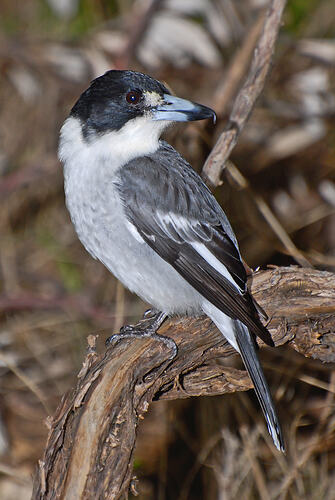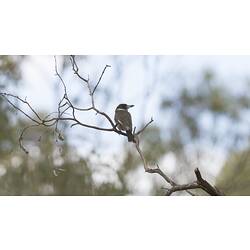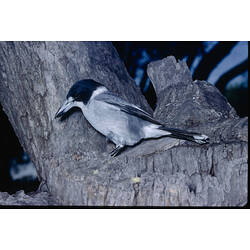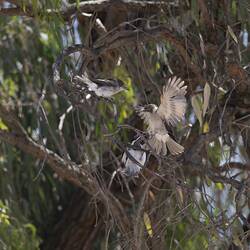General Description
Adult Grey Butcherbirds have a black face and head, grey body and wings, and white underparts, throat and neck stripe. They have a large grey and black bill, with a small hook at the end of the upper bill. Juveniles resemble adults, but are olive-brown instead of black, with buff-white throats and underparts. Bill to tail length is up to 30 cm. Butcherbirds have a distinctive, melodious piping call.
Biology
Grey Butcherbirds are aggressive predators, feeding on insects, reptiles, small rodents and small birds. They usually hunt from exposed perches, pouncing down on their prey to catch it. They impale some of their prey on sticks or hang it in tree forks or crevices, storing it up to be eaten later. They also eat some fruits and seeds. Young birds remain within their parents' breeding territory for a year, helping to raise the next brood. Clutch size is three to five eggs. Nests are typically built in a tree fork within 10 m of the ground.
Distribution
Mainland Australia and Tasmania.
Habitat
Forests, woodlands, scrublands and urban areas.
More Information
-
Animal Type
-
Animal SubType
-
Brief Id
A medium-sized bird with a black head and grey body. Has a characteristic hooked beak.
-
Colours
Grey, Black, White
-
Maximum Size
30 cm
-
Habitats
-
Diet
Carnivore
-
Diet Categories
Insects
-
Endemicity
-
Conservation Statuses
CITES: Not listed, FFG Threatened List: Not listed, EPBC Act 1999: Not listed, IUCN Red List: Least Concern
-
Taxon Name
-
Scientific Author
(Latham, 1802)
-
Common Name
Grey Butcherbird
-
Kingdom
-
Phylum
-
Subphylum
-
Class
-
Order
-
Family
-
Genus
-
Species Name
torquatus







